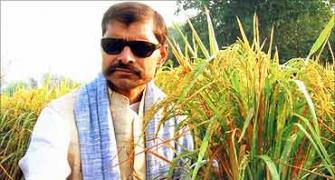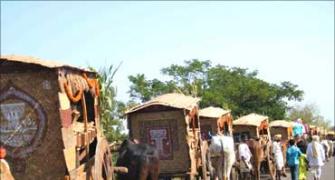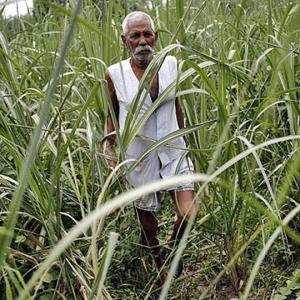 A delayed monsoon and abundant cotton in the international market could spell trouble in the state's suicide zone.
A delayed monsoon and abundant cotton in the international market could spell trouble in the state's suicide zone.
As the skies stayed clear till the second week of June, Ramesh Gulabhrao Digde's mood darkened.
His two acres were ploughed at great expense, the seeds were purchased, and a sack of fertilisers lay in a corner of his thatch-roofed hut in Parsodi village in western Maharashtra's Yavatmal district. But the rains had played truant.
On June 17, Ramesh tired of the wait and swallowed a phial of pesticide. "He kept saying 'moneylender, moneylender'," said his son, who found Ramesh in a delirious state and took him to a hospital, where the 56-year-old farmer breathed his last.
That night, clouds gathered over the baked fields in Parsodi and the rains finally poured down.
Ramesh's neighbour, Sureshrao Ramdas Digde, 55, had planted early this year. On June 6, he sowed 12 bags of cottonseeds on his five-acre farm; the seeds never germinated. A day after Ramesh's death, he sowed another 12 bags.
The rains, however, stopped as mysteriously as they had begun and Sureshrao's second crop failed, too.
On July 26, when the farmers of Parsodi went out to their fields to sow the cotton crop for the third time in a month, Sureshrao stayed at home and reached for the pesticide.
"He was dead when I came home," said Rajendra Dighde, Sureshrao's younger brother. "He needed this crop to repay his earlier debts, but the rains failed him."
Erratic rains in Maharashtra's cotton belt have forced farmers to sow their fields a number of times. This, in some instances, has increased individual debts, as farmers who exhausted their institutional credit have borrowed money from informal moneylenders to finance the replanting of fields, raising the spectre of further deaths around harvest time.
In 2012, 3,786 farmers committed suicide in Maharashtra, according to the most recent data provided by the National Crime Records Bureau. The number of farmers who committed suicides due to crop-related issues this year isn't known.
Recent reports suggest the rainfall deficit in Maharashtra's cotton belts of Vidarbha and Marathwada has widened; Marathwada is now facing a 60 per cent deficit, while the shortfall in Vidarbha is 23 per cent. Statistics from the Ministry of Agriculture indicate farmers across the country have planted more cotton this year compared to the last, as the crop is considered drought-resistant compared to other options such as soybean.
Farmers hope a revitalised monsoon could yet result in good yields and good profits, but a perfect storm of local, national and international factors could mean low cotton prices, lower profits and persistent indebtedness.
"International cotton prices have fallen this year," said Faiyaz Hudani, associate vice-president (research) at Kotak Commodities.
"October futures for cotton on the ICE benchmark index have fallen 26 per cent in the past month, while October futures on Indian exchanges have fallen 15 per cent."
Globally, cotton prices have been depressed by a very good harvest in the US, which has brought additional supply to the market, while global demand for cotton has slowed, as China, the world's largest cotton producer and importer, has imported 42 per cent less in the first six months of this year.
This year, the Chinese government is replacing a 2011 cotton stockpiling policy with a crop-subsidy programme. It hasn't released any further details.
Hudani said it was difficult to predict spot prices in October but added he expected prices to be slightly below last year's levels. "Price movement will be sideways to negative," he said.
"International prices are the main drivers of domestic cotton prices in India," said D K Nair, secretary-general of the Confederation of Indian Textile Industry.
He added cotton futures trading in India was negligible, adding traders took price cues from domestic and international exchanges. "The price will also be affected by the exchange rate and the market's anticipation of the price in the following year."
Nair cautioned cotton procurement by China was hard to predict. As the world's largest player in both cotton and textiles, China, like India, must strike a balance between adequately compensating its cotton farmers and providing raw materials at competitive prices to the textile sector.
"China has very large stocks; a big appetite for cotton; and little public information," Nair said. "If it decides to reduce stocks, prices could fall; if they increase stocks, prices could rise."
He estimated this year, cotton prices would be lower than last year, though these would be more than the government's minimum support price of Rs 4,050 a quintal for long-staple cotton.
In Parsodi, farmers are making their own calculations. "Cotton planting costs about Rs 15,000 an acre," said Rajendra, the farmer. "In a good year, the yield could rise to 10 quintals to the acre, which means a reasonable profit of Rs 25,000 an acre."
A study by S Parasuraman and T Rajaretnam of the Tata Institute of Social Sciences shows 40 per cent of Vidarbha's farmers own between two and five acres of land that yield an average 6.5 quintals of cotton each. Only 10 per cent of these households have irrigated land. The median household income in 2008-09, the survey showed, was Rs 39,000.
"I have sowed my fields thrice this year; so, my input costs have gone up a great deal," Rajendra said, adding he had also taken a loan of about Rs 30,000 from a private money lender at five per cent a month, or 60 per cent a year.
The monthly interest means farmers sell their produce early to pay off their loans, rather than hold on to the cotton until the price is right. Last year, for instance, Ujwala Pedkar, a cotton farmer in the neighbouring district of Wardha, grew 30 quintals of cotton, 25 quintals of which she sold at the minimum support price of Rs 4,000 a quintal to pay her debts. She sold the remaining five quintals at the end of the season, at Rs 5,500 a quintal.
Pedkar is uncomfortably aware of the implications of creeping interest rates - 12 years ago, her husband Prabhakar Pedkar killed himself when he couldn't repay a moneylender who appropriated part of the family farm. "Now, I pay my debts as soon as I can," she says.
"The trader takes a loan at 12-13 per cent a year to buy cotton from a farmer who borrows money at 60 per cent," said an industry representative. "Who do you think can hold out longer?"










